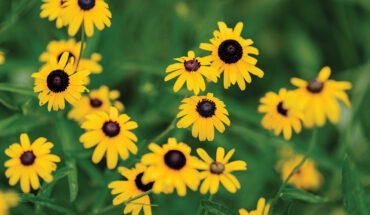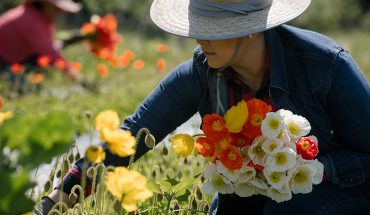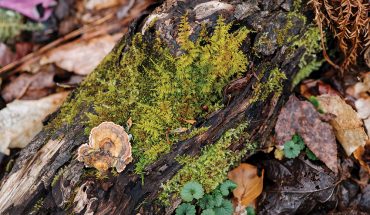Leave the leafs, bury the bulbs, observe, and give thanks as you work in your patch of Peidmont this month.
by Hannah Ross | photography from the archives by Juli Leonard
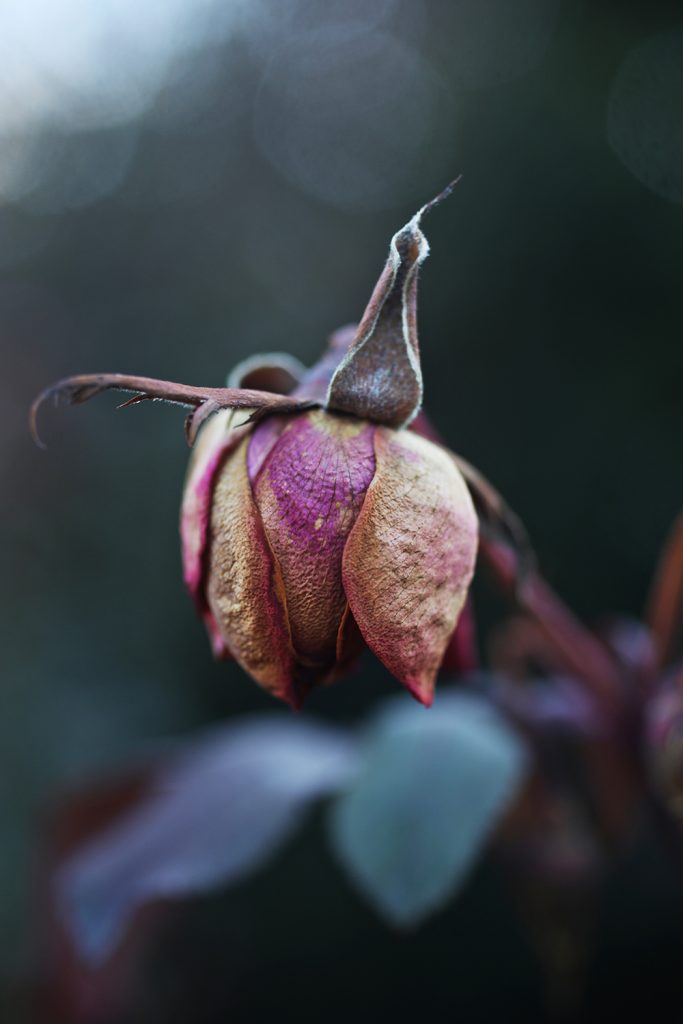
Summer lingers late in the Piedmont, but with the deep chime of November, autumn has undeniably arrived. November brings swift transformation, gilded and shadowed. We gather summer’s last fruits alongside chattering birds, and watch the towering overgrowth topple under the first breath of frost. In the garden, this month is a bit like the quiet, solitary hour before bed, when we prepare for rest and arrange for our eventual awakening. But even as we wind down, there is activity and awakening still occurring. The processes of rest and rising, emergence and decay are in a constant dance; the garden shows us that life’s path isn’t linear. This month, we witness and give thanks for all of it, messy as it may sometimes feel. Take these seven tips to heart for stewarding your November garden.
Leave your Leaves
The sight of gossamer leaves adrift is a lovely one, but for many of us, it’s also a reminder of work to be done. The good news? Most of the leaf cleanup we do is unnecessary and even counterproductive to the health of our landscapes. Fallen leaves are pure gold for trees and gardens. When left around the base of trees, leaf detritus offers deep nourishment, in keeping with nature’s design. Throughout decomposition, leaves contribute organic matter and nutrients to the soil, and support the thriving microbial communities that keep roots happy and plants flourishing. Fallen leaves also act as mulch, helping to retain water and insulate roots from the elements.
These same benefits apply to edible and ornamental gardens, where leaves can be used as mulch or as a carbon source in the compost pile. Around delicate young plants, it’s best to use already broken-down leaves as mulch (either manually chopped or partially decomposed), rather than freshly fallen leaves. Known as leaf mould or leaf mulch, it allows for greater circulation of air and water, and is easier to place delicately around tender plants. If you don’t have many trees in your yard and want to access this incredible, sustainable nutrient source, leaf mulch can be purchased affordably by the cubic yard from the City of Raleigh Yard Waste Center.
Every November and December, I work to channel the leaves towards their greatest purpose. My garden is shaped in long, permanent raised beds with pathways in between. I rake fallen leaves from the lawn (leaving those around trees intact), heap them onto a tarp, and drag them into the garden. I dump the leaves into each pathway, and rake out a deep layer of (free!) mulch between each bed. This does wonders for weed suppression, erosion prevention, and soil biology activation. It also gives the garden a tidier, well-tended appearance. Over the course of the growing season, the damp heat of summer will break the leaves down, leaving the pathways brimming with humus-rich soil that can later be shoveled up onto the raised beds to build their depth and structure. Goodbye, compacted clay! By the time the leaves have broken down, it’s autumn again, and time to move more leaves around. Don’t be surprised if you spot me cruising through neighborhoods, snagging the bagged leaves placed on the curb for disposal. And as you watch the leaves blanket your yard this season, I hope you’ll see them for what they are: a gardener’s riches.
Tidy Up, But Not Too Much
As frost becomes frequent, verdant greens fade to reveal an earth-toned architecture of dried flower heads, seedpods, berry boughs, and branches. While it can be tempting to prune everything in sight, step back and observe. At sunrise, where do you find the birds perched, gathering seeds in between songs? Look more closely: where are the beneficial insects burrowing? Thoughtful fall cleanup is a balance between clearing the canvas for next season, and stewarding habitat and food sources for wildlife. It is fine to clear spent annuals and food crops, chopping and composting the detritus. If any plant matter is diseased, it should be fully removed and disposed of, in the garbage rather than the compost. But as much as you can stand, leave seed pods, fallen leaves, branches, and nesting sources in place. These elements are especially prevalent in perennial beds and beneficial hedgerows, so embrace a natural aesthetic in these areas of the garden. Do your renewal pruning as new growth starts to emerge in spring; natural food sources will be appearing by the day at that point, and your dried seed pods will no longer be a lifeline.
Save Seeds
While we now know to leave most seedheads intact for the birds, gathering a modest amount of seeds to save for next year’s planting will reap bountiful rewards, and save significant money over time. Beyond pragmatism, seed saving is an ancient practice of preserving heritage, memory, family food stories, and connection to the land. Many immigrant families hold stories of grandmothers sewing seeds into their clothing even as they left everything else behind, and planting them in unfamiliar ground— each tiny seed a tether to so much more than taste. Try your hand at seed saving as a way to weave your own garden traditions, and to honor those of others. The key is to select seeds from native, heirloom and open-pollinated varieties rather than from hybrids, to ensure that the seed you collect produces the plant you expect next season.
To collect seeds for saving, snip a handful of dried seed heads from the garden. Bundle them together inside of a paper lunch bag, then hang each bundle upside down indoors to dry. The seeds will start to drop on their own, and the bag will catch them. After a month or so, give the stems a shake to release the rest of the seeds into the bag. Save the preserved seeds in labeled jars in the fridge until you’re ready to plant them. This basic strategy works best for flowering plants that produce visible seeds not encased in fruits or pods. For vegetable seed saving tips, check out this invaluable guide from Southern Exposure Seed Exchange.
Plant Bulbs for Spring Beauty
November is the time to tuck spring-blooming bulbs into the garden. Flowering bulbs like tulips, daffodils, Dutch iris, hyacinth, and fritillaria all require a period of exposure to cold before blooming, so planting now allows them ample preparation for their spring show. Try incorporating bulbs into perennial plantings and ornamental borders, in clusters of at least ten bulbs each for greatest visual impact. When layered into a perennial landscape, the bulb display will add early season interest while most perennials remain dormant; as the bulbs fade, the perennials will fill in their space. Bulbs also do well planted in porch containers for joyful, hospitable displays; place your pots in a sunny location, and cover the soil with a layer of leaf mulch to protect it from temperature swings. Refer to October’s gardening tips to learn about direct seeding hardy annual flowers for spring blooms; this month is still within the window for planting. Through a combination of fall-planted hardy annual seeds and bulbs, you will be stunned by the blossoming spring bounty you can create with minimal effort.
Winterize the Garden
Deep freezes are right around the corner, so now is the time to go through your winterizing checklist. Have you shut off your irrigation system and drained hoses? Have you siphoned excess fuel out of your gas-powered tools? Do your hand tools need cleaning and oiling? As long evenings in the garden dwindle to a bit of twilight after work, it can be comforting to perform these tidying tasks when there is little daylight for others.
In the garden, grace your beds with a generous layer of leaf, bark, or straw mulch. Mulching the beds — even the unplanted ones — helps insulate the soil’s microbial communities from winter’s harsh edge. Compost can also be used as mulch. The only areas of the garden that don’t need mulch are those under a cover crop (see October’s tips for more on cover crops; November is still within the window for planting some of them, like rye and winter pea).
Remember to dig up tender perennials and bulbs before the first hard freeze. Delicate plants like geranium and begonia overwinter well indoors and can be planted back out next spring. If you grew dahlias this year, decide whether to dig the tubers up, or overwinter them in the ground. While they must be dug and stored in colder zones, here in zone 7 we are able to overwinter dahlia tubers under a deep layer of mulch. Note that dahlia tubers still need to be dug and divided every three years for continued abundance. If you have tender vegetables like lettuce planted, have frost cloth handy and cover them during freezing temperatures. Using frost cloth or caterpillar tunnels allows you to harvest vegetables well into (and even through) the winter.
Keep Growing Food
Believe it or not, you can still plant food in November, in addition to harvesting cool season vegetables planted in late summer or early fall. My favorite spring delicacy to plant this month is fava bean. Favas are exceptionally cold-tolerant and produce stunning black-and-white flowers in late winter, with beans ripening around April if planted this month. The fava bean gets bonus points for being a nitrogen-fixing cover crop in addition to an ornamental and edible delicacy. Favas may experience cold damage under 20 degrees — just cut back any damaged, blackened foliage, and they will bounce back.
Cold-hardy greens in the chicory family, like escarole and endive, can be planted now and kept under row cover for early spring harvest. If you read last month’s gardening tips, you already know how to plant garlic; November is still a great time for it, as well as for bulb onions. Asparagus crowns can be tucked into the ground in November, with harvestable spears coming three years later. Continue to plant fruit-bearing trees, vines, and shrubs like blackberries, persimmons, and figs this month as well. When you take time to plant a little bit of food every month (even in the cold), you will be surprised at the consistency and variety of your harvests. Your future spring tables will thank you for this fall proactivity.
Give Thanks
As we enter this season of rest and gratitude, remembering the bounty of the garden is one of my favorite aspects of Thanksgiving. For the past several years, I have sown carrots in August that have matured just in time for Thanksgiving, and it brings me deep contentment to roast them whole and savor them alongside my dearest loves. When we ground ourselves in the seasons and grow our own food— even in the smallest amounts— we are more likely to recall the many hands and life cycles that keep us fed and well. In this spirit of gratitude, I have a blessing to share that my grandfather loved and often repeated, everyone holding hands around the table. I have altered the words to suit my purpose of thanking the garden (I inserted “Earth” where Papa would say “God”); I encourage you to tweak the last phrase to suit however and to whomever you and your family give thanks. It is an old family blessing with universal resonance, recalling not only abundance, but also generosity, hope, and joy:
The ripening fruit on the garden wall
Is telling us there’s food for all
So gather ‘round and get your share
For the love of Earth is everywhere
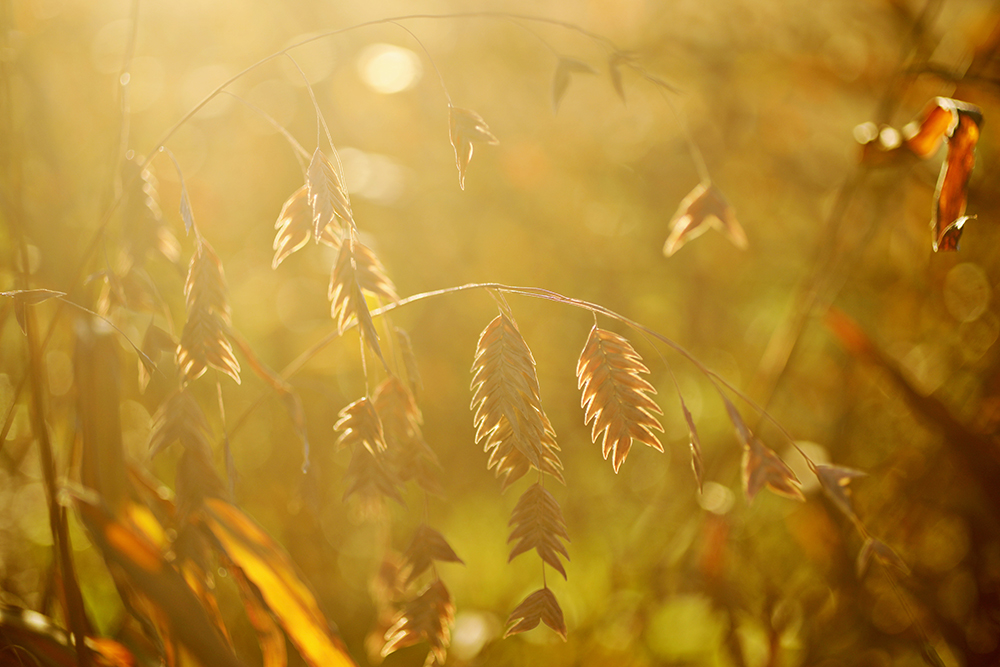
This article was originally published in November, 2021 on waltermagazine.com

